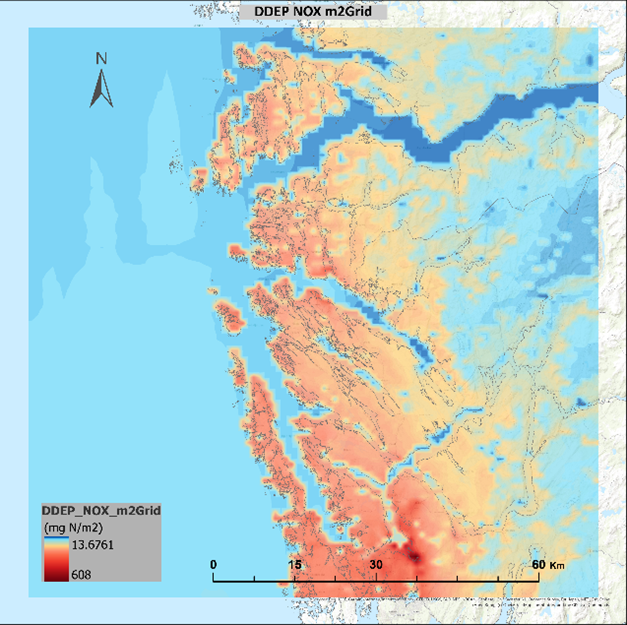The EMEP MSC-W model (Simpson et al., 2012) is a state-of-the-art chemical transport model (CTM) that is widely used for air quality and PM assessments. It is an open source model (https://github.com/metno/emep-ctm) developed at the Norwegian Meteorological Institute. The model is a part of the regional air quality (RAQ) production of the Copernicus Atmosphere Monitoring Service (CAMS) (http://atmosphere.copernicus.eu).
The EMEP model can be used with various chemistry schemes. One option is the so-called EMChem09 scheme that contains ~70 chemical species, 140 chemical reactions and 30 photo-dissociation reactions (Simpson et al., 2012). It is relatively simple to include new chemical species and reactions relevant for a specific pollution scenario, e.g. by using the GenChem pre-processing tool (Simpson et al., 2020).
In the standard EMEP model anthropogenic emissions from ground-level sources are supplied as gridded annual fields of NOx, NH3, SO2, fine and coarse particulate matter, CO, and non-methane VOC (NMVOC), modified with monthly, daily and hourly factors. Emissions of these seven species, divided into 11 different emission sectors, are available globally for a grid resolution of 0.1° × 0.1° longitude-latitude.
The EMEP model was traditionally used at 50 × 50 km2 resolution over Europe, but the model has significantly developed the last decade. Today the EMEP model is flexible with respect to input meteorological data and domain, with applications ranging from 1 × 1 km2 to 1° × 1° globally.
The EMEP model can be used in combination with various meteorological drivers. One option is the WRF (Weather Research and Forecasting) model, which is an open source meteorological model developed at NCAR (https://github.com/wrf-model/WRF). The same projection and vertical resolution are normally used in the EMEP model as in WRF. Thus, there is no need for spatial interpolation or processing of meteorological data when WRF data are used as input to the EMEP model.
At NILU the WRF-EMEP model system has been used in several assessment studies for the industry, projects initiated by the ministry (related to e.g. oil/gas installations), and for research purposes. It has also been used to assess the environmental impact of in-air amine emissions from post-combustion carbon dioxide capture (Karl et al., 2014).
Requirements
The WRF-EMEP system described above is based on open access source models and input data. However, for a fine scale model runs (e.g. ~1km grid resolution) the model performance will improve significantly if local emission sources are provided. In addition, information about local point sources (stacks) are needed. For such point sources, the following parameters should be provided:
- Location of point source (latitude, longitude)
- Emission of pollutants (kg/yr)
- Height of stack (m)
- Stack temperature (K)
- Stack diameter (m)
- Exit velocity (m/s)
Contacts:
Tove Svendby (tms@nilu.no), Sverre Solberg (sso@nilu.no)
References
Karl, M., Castell, N., Simpson, D., Solberg, S., Starrfelt, J., Svendby, T., Walker, S.-E., Wright, R.F. (2014) Uncertainties in assessing the environmental impact of amine emissions from a CO2 capture plant. Atmos. Chem. Phys., 14, 8533-8557. https://doi.org/10.5194/acp-14-8533-2014
Simpson, D., Benedictow, A., Berge, H., Bergström, R., Emberson, L. D., Fagerli, H., Flechard, C. R., Hayman, G. D., Gauss, M., Jonson, J. E., Jenkin, M. E., Nyíri, A., Richter, C., Semeena, V. S., Tsyro, S., Tuovinen, J.-P., Valdebenito, Á., and Wind, P.: The EMEP MSC-W chemical transport model – technical description, Atmos. Chem. Phys., 12, 7825–7865, https://doi.org/10.5194/acp-12-7825-2012, 2012.
Simpson, D., Bergström, R., Briolat, A., Imhof, H., Johansson, J., Priestley, M., and Valdebenito, A.: GenChem v1.0 – a chemical pre-processing and testing system for atmospheric modelling, Geosci. Model Dev., 13, 6447–6465, https://doi.org/10.5194/gmd-13-6447-2020, 2020.

